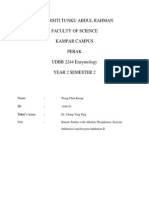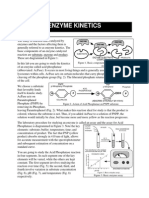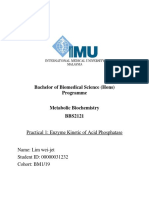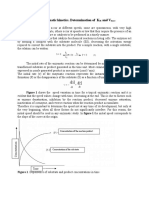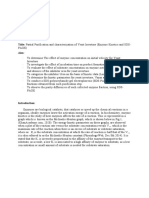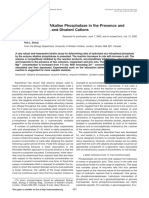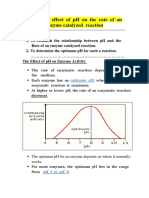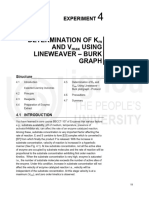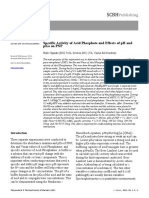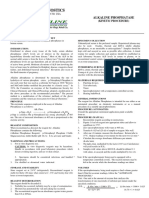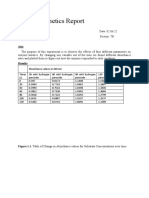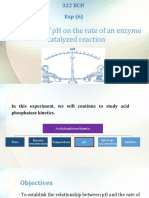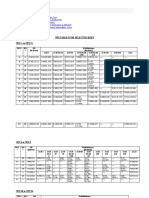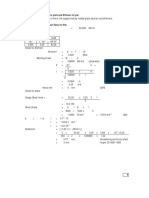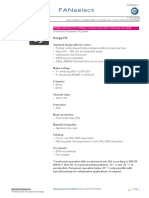Introduction
Most biochemical reactions in living things depend on the function of enzymes, which
are influenced by a variety of physical characteristics including pH, temperature, and
time as well as certain external elements like toxins, medications, and inorganic
compounds. Enzyme kinetics and inhibitions are terms used to analyse these
variables and the pace of enzymatic processes. The Michaelis-Menten equation
yields the conventional parameters Km and Vmax, which are used to assess these
factors. The Lineweaver-Burk plot is another method used to depict the reciprocal of
substrate concentration and velocity. (Robinson, 2015)
We utilized acid phosphatase, an enzyme that hydrolyses phosphoric acid esters,
and p-nitro phenol (PNP) and p-nitro phenol phosphatase (PNPP) as substrates in
this investigation. (Dean, 2002) As an inhibitor and substrate combination, Na3PO4
and NaF are used to measure the amount of inhibition of enzyme reactivity.
Objective
To understand enzyme function and regulation
To identify kinetic parameters such as Km and Vmax
To understand the effect of different inhibitors on enzyme activity as
competitive and non-competitive inhibitors
Materials
Reagents
1mM p-nitrophenol (PNP)
50mM sodium acetate (NaOAc)
1M NaOH solution
2.7mM p-nitrophenol phosphate (PNPP)
1mg/ml pure acid phosphatase enzyme
Deionised H2O (dH2O)
0.1M acetic acid
0.1M NaOAc
1mM trisodium phosphate (Na3PO4) solution, pH4.5
1mM sodium fluoride (NaF), pH 4.5
10mM ammonium molybdate ((NH4)6Mo7O24) solution, pH4.5
Equipments
1 * 96 wells microplate
Microtitre plate reader
pH meter and strips
Hot water bath or block
Ice water bath
Thermometer
�Methods
To study enzyme kinetics and inhibition, all followed methods are from the laboratory
manual of the medical biochemistry (MLS245), department of faculty of health, CDU.
Part A: Preparation of a Standard curve of Product concentration
First, seven solutions ranging in concentration from 0 µM to 500 µM are made as 1
ml each using a separate 1 mM PNP stock solution and 50 mM NaOAc as a diluent.
50 µL of 1M NaOH should be added to each well in the 96-well plate before
transferring 100 µL of each solution into its respective well. Using a wavelength of
405 nm, the spectrophotometer measures the absorbance of each well.
Part B: Measuring the rate of an enzymatic reaction
A system of 100 µL of specific volume of 2.7mM PNPP
(0.0,2.7,5.0,7.5,10.0,12.5,15.0,17.5,20.0,30.0,40.0,50.0) in microcentrifuge tubes
with 50mM NaOAc as diluent was used for the enzymatic reaction. After that, each
tube is incubated for five minutes at 37°C in a hot water bath. Following the first
incubation, 10 µL of acid phosphatase (1 mg/ml) enzyme was added right away.
Continued to incubate at 37°C for 5 minutes. After the second incubation, 50 µL of
1M NaOH is added. After transferring 140 µL from each tube to a separate 96-well
plate cell, the absorbance measurement at 405 nm is conducted.
Part C: Enzyme Reaction in the presence of trisodium phosphate
This experiment was carried out using a new diluent, 50 mM NaOAc + 1 mM
Na3PO4, placed in microcentrifuge tubes, while maintaining the same concentration
of PNPP from Part B. Later, each step is carried out in a manner akin to that of Part
B.
Part D: Enzyme Reaction in the presence of sodium fluoride
This experiment was conducted using the same procedures as Part B, using 50 mM
NaOAc and 1 mM NaF, and the same dose of PNPP.
Results
Part A: Preparation of a Standard curve of Product concentration
When comparing the experimental dataset's straight-line PNP concentration
standard curve to the control data, the R2 value is comparable. (Figures 1A and 1B)
Since the R-squared value is about 1, the concentration of PNP at 405 nm
absorbance may be precisely determined.
� 3 3.5
2.5 3
f(x) = 0.0047779187 x + 0.0499308575 f(x) = 0.005852375201 x − 0.008713164251
R² = 0.999501049978268 R² =2.5
0.999741409476546
2
Absorbance
Absorbance
2
1.5
1.5
1
1
0.5 0.5
0 0
0 100 200 300 400 500 600 0 100 200 300 400 500 600
PNP concentration PNP concentration
Figure 1A: A purple-coloured straight-line graph plotting the control data for PNP concentration versus
absorbance at 405 nm.
Figure 1B: Blue-coloured, straight-line graph plotting PNP concentration control data versus
absorbance at 405 nm
Part B: Measuring the rate of an enzymatic reaction with non-inhibitors
The control data's M-M plot, which displays an enzyme's affinity for substrate binding
capacity, is shown as a hyperbolic curve. The discrepancy in the R-squared value
represents experimental error.
0.7 0.08
f(x) 0.6
= 0.00046478798 x + 0.26289855072 0.07 f(x) = 5.00000000000001 x
R² = 0.894323947161681 0.06 R² = 1
0.5
0.05
0.4
Vmax
1/ Vi
0.04
0.3
0.03
0.2
0.02
0.1 0.01
0 0
0.0 200.0 400.0 600.0 800.01000.0 0 0.005 0.01 0.015 0.02
pNPP concentration 1/ [S]
Figure 2A & 2B: A linear graph of control dataset of substrate concentration in the presence of
enzyme acid phosphatase (AP) denoted as Michaelis-Menton (M-M) plot and reciprocal data is
denoted as Lineweaver-burk (L-B) plot.
� 1.6 0.08
f(x) = 0.00638271605 x + 0.62966666667
R² =1.4
0.43352260017923 0.07 f(x) = 5.00000000000001 x
1.2 R² = 1
0.06
1
0.05
0.8
0.04
1/Vi
V
0.6
0.03
0.4
0.02
0.2
0.01
0
0 20 40 60 80 100 120 140 160 180 0
0 0.005 0.01 0.015 0.02
PNPP concentration 1/Km
Figure 3A & 3B: A linear graph of experimented dataset of substrate concentration in the presence of
enzyme acid phosphatase (AP) denoted as Michaelis-Menton (M-M) plot and reciprocal data is
denoted as Lineweaver-burk (L-B) plot.
Part C: Enzyme Reaction in the presence of trisodium phosphate (Na 3PO4)
Plots show a resemblance with R-squared values, allowing evaluation of both data
when a noteworthy high rate of product development occurs.
0.3 18
f(x) = 0.00274867724867725 x + 0.02625 16
0.25
R² = 0.969564325756499 f(x) = 936.250280671 x + 1.82176533617
14
R² = 0.999575792881934
0.2 12
Absrobance
0.15 10
1/Vi
8
0.1
6
0.05 4
2
0
0
0 0.005 0.01 0.015 0.02
Substrate Concentration 1/Km
Figure 4A & 4B: Two, M-M (left) and L-B (right) plot are plotted using control data set indicating
absorbance against substrate concentration in the presence of Na3PO4.
� 0.8 0.08
f(x) =0.7
0.00639153439 x + 0.16171428571 0.07 f(x) = 5.00000000000001 x
R² = 0.973828180785622
R² = 1
0.6 0.06
Absorbance
0.5 0.05
1/Vi
0.4 0.04
0.3 0.03
0.2 0.02
0.1 0.01
0 0
0 10 20 30 40 50 60 70 80 90100 0 0.005 0.01 0.015 0.02
Substrate Concentration 1/Km
Figure 5A & 5B: Two, M-M (left) and L-B (right) plot are plotted using experimental data set indicating
absorbance against substrate concentration in the presence of Na3PO4.
Part D: Enzyme Reaction in the presence of sodium fluoride (NaF)
In compared to the rate of product between two inhibitors, NaF have higher rate. The
R-squared values of both study is similar, so difference is negligible.
0.25 18
f(x) = 0.00223368607 x + 0.03183333333 16
R² = 0.942897585783606 f(x) = 945.603145368 x + 1.99996126666
0.2
R² =140.959032135335569
12
Absorbance
0.15
10
1/Vi
8
0.1
6
0.05 4
2
0 0
0 10 20 30 40 50 60 70 80 90100 0 0.005 0.01 0.015 0.02
Substrate Concentration 1/Km
Figure 6A & 6B: The left plot is M-M and Right is L-B of the control data of substrate concentration
with NaF as inhibitor against the absorbance.
� 0.4500 14
0.4000
12
f(x) = 0.00351587302 x + 0.05685714286 f(x) = 766.012288659 x + 0.97159350443
0.3500 R² = 0.995404938463471
R² = 0.97370634906634
10
0.3000
Absorbance
0.2500 8
1/Vi
0.2000 6
0.1500
4
0.1000
2
0.0500
0.0000 0
0.0 20.0 40.0 60.0 80.0 100.0 0 0.005 0.01 0.015 0.02
Substrate Concentration 1/Km
Figure 7A & 7B: The left plot is M-M and Right is L-B of the experimental data of substrate
concentration with NaF as inhibitor against the absorbance.
Discussion
Control Data Experimental Data
Non- NaF Na3PO4 Non- NaF Na3PO4
Inhibitor Inhibitor
Km 0.019 0.069 0.102 0.010 0.061 0.039
Vmax 3.80 31.44 38.02 1.58 17.57 6.18
When comparing the two sets of data, it can be seen that the experimental data
shows a reduction in substrate concentration when inhibitors are present, but the
control data shows the reverse. Velocity's value varies as well. Therefore, the
experiment might not be the best for supporting the theories of enzyme inhibition and
kinetics. Theoretically, a rise in substrate concentration will likewise result in an
increase in PNPP concentration in the absence of enzyme inhibitors. Product
concentrations drop when enzyme inhibitors are present because of their impact on
enzyme activity. In summary, the study's theoretical evidence does not support the
presence of enzyme inhibition. (Ilia et al., 2023)
References:
Dean, R. L. (2002). Kinetic studies with alkaline phosphatase in the presence and
absence of inhibitors and divalent cations. Biochemistry and Molecular
Biology Education, 30(6), 401-407.
https://doi.org/https://doi.org/10.1002/bmb.2002.494030060138
Ilia, G., Simulescu, V., Plesu, N., Chiriac, V., & Merghes, P. (2023). Wittig and
Wittig-Horner Reactions under Sonication Conditions. Molecules, 28(4).
https://doi.org/10.3390/molecules28041958
Robinson, P. K. (2015). Enzymes: principles and biotechnological applications.
Essays Biochem, 59, 1-41. https://doi.org/10.1042/bse0590001



